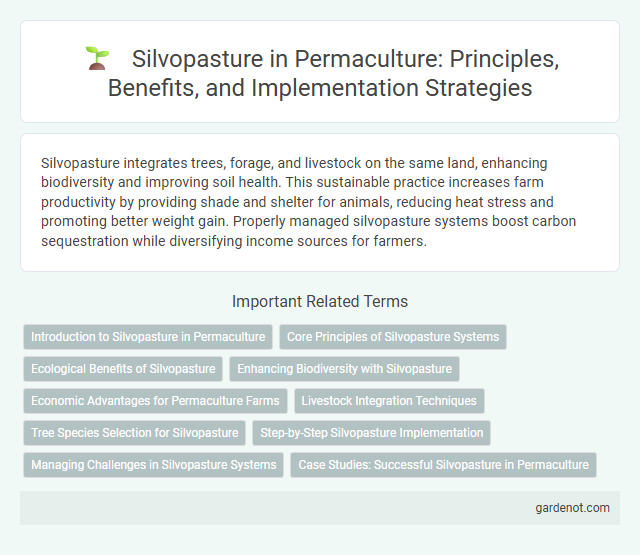Silvopasture integrates trees, forage, and livestock on the same land, enhancing biodiversity and improving soil health. This sustainable practice increases farm productivity by providing shade and shelter for animals, reducing heat stress and promoting better weight gain. Properly managed silvopasture systems boost carbon sequestration while diversifying income sources for farmers.
Introduction to Silvopasture in Permaculture
Silvopasture integrates trees, forage plants, and livestock in a mutually beneficial system that enhances biodiversity and improves land productivity in permaculture design. This agroforestry practice optimizes spatial and temporal interactions among species, providing shade, shelter, and diverse forage while promoting soil health and carbon sequestration. Implementing silvopasture contributes to sustainable land management by increasing resilience to climate variations and reducing the need for chemical inputs.
Core Principles of Silvopasture Systems
Silvopasture integrates trees, forage, and livestock to create resilient agricultural ecosystems, enhancing biodiversity and improving soil health. Core principles include strategic tree selection for shade and fodder, rotational grazing to prevent overgrazing, and maintaining a balance between tree canopy and pasture productivity. This system maximizes land use efficiency while promoting sustainable livestock management and carbon sequestration.
Ecological Benefits of Silvopasture
Silvopasture integrates trees, forage, and livestock, significantly enhancing biodiversity and soil health through natural nutrient cycling and carbon sequestration. This agroforestry practice reduces erosion, improves water retention, and creates wildlife habitats, contributing to a resilient and sustainable ecosystem. Research shows silvopasture can increase carbon storage by up to 30% compared to conventional pasture systems.
Enhancing Biodiversity with Silvopasture
Silvopasture integrates trees, forage, and livestock to create diverse habitats that support a wide range of species, enhancing overall ecosystem health. The combination of woody perennials and pasture plants increases structural complexity, promoting habitat variety for birds, insects, and soil organisms. This method not only boosts biodiversity but also improves soil fertility and resilience against pests and diseases.
Economic Advantages for Permaculture Farms
Silvopasture integrates trees, forage, and livestock, boosting farm income through diversified revenue streams such as timber sales, animal products, and forage crops. This system reduces input costs by enhancing soil fertility, decreasing erosion, and improving microclimates, which in turn lowers the need for external feed and fertilizers. Economic resilience is enhanced as silvopasture mitigates market fluctuations by producing multiple commodities year-round.
Livestock Integration Techniques
Silvopasture integrates livestock such as cattle, sheep, or goats with trees and pasture to enhance ecosystem productivity and biodiversity. Techniques include rotational grazing to prevent soil compaction, strategic tree planting for shade and shelter, and managing understory vegetation to provide diverse forage. Proper integration supports animal welfare, improves soil health, and increases overall farm resilience.
Tree Species Selection for Silvopasture
Tree species selection for silvopasture emphasizes fast-growing hardwoods like black locust and nitrogen-fixing species such as alder to enhance soil fertility and provide quality fodder. Deep-rooted trees like walnut and chestnut improve nutrient cycling while offering valuable timber alongside pasture benefits. Choosing drought-tolerant and locally adapted species ensures resilience and optimal growth in silvopasture systems.
Step-by-Step Silvopasture Implementation
Silvopasture integrates trees, forage, and livestock in a sustainable agricultural system by following a structured implementation process. Begin with site assessment and selecting compatible tree species such as nitrogen-fixing trees or deep-rooted hardwoods that enhance soil health and provide shade. Plant trees in designed patterns to balance pasture access and animal shelter, then introduce rotational grazing practices to optimize forage growth and prevent soil compaction, ensuring long-term ecosystem productivity.
Managing Challenges in Silvopasture Systems
Managing challenges in silvopasture systems involves addressing tree-crop-livestock interactions to optimize productivity while minimizing competition for resources. Soil compaction from grazing animals requires strategic rotation and maintaining proper ground cover to preserve soil health. Implementing integrated pest management and monitoring shading effects on pasture growth ensures sustainable and balanced ecosystem functioning.
Case Studies: Successful Silvopasture in Permaculture
Silvopasture integrates trees, forage, and livestock to enhance productivity and sustainability in permaculture systems. Case studies from regions such as the southeastern United States demonstrate increased livestock weight gain and improved soil health through diverse tree species like oaks and pines combined with managed grazing. Research from New Zealand highlights reduced erosion and enhanced biodiversity in silvopasture systems that balance tree canopy density with pasture growth.
Silvopasture Infographic

 gardenot.com
gardenot.com